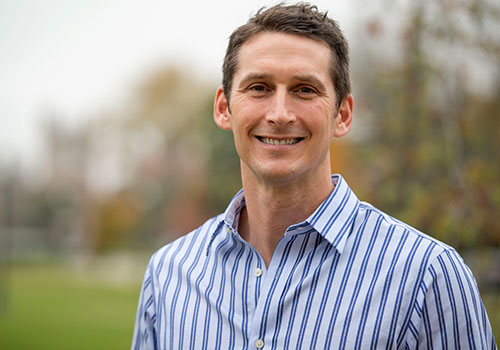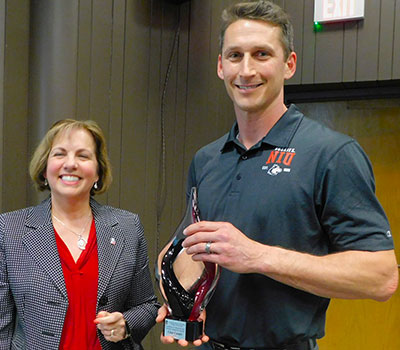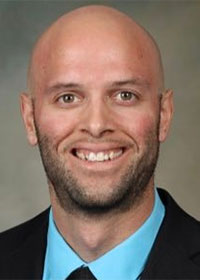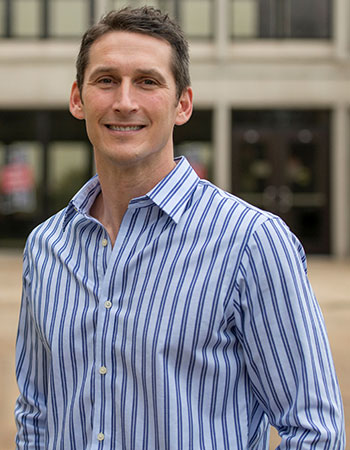
Many college-age athletes of all skill levels are taking pre-workout supplements to enhance their physical performance, stamina and recovery.
But do they know what’s in them – or, more importantly, whether they’re effective and safe at recommended doses?
The latter is what Clayton Camic aims to discover as the college’s Senior Faculty Fellow for 2022-24.
Camic and collaborator Andrew Jagim, director of Sports Medicine Research at Mayo Clinic Health System, will further their five-year research agenda that already has produced several publications and presentations.
“Our findings have largely shown pre-workout supplements to be effective for improving energy expenditure, resistance to fatigue, muscular strength and endurance, as well as perceived exertion during exercise of wide-ranging intensities,” Camic says.
Yet “our work has also demonstrated that over 70% of young individuals who utilize pre-workouts have been consistently supplementing for more than one year,” he adds. “Over 50% have experienced adverse events from ingestion, and many reported that they fail to follow the recommended dosing instructions by the manufacturer.”
 Whether those risky choices include ingesting two or more servings, or combining the supplements with other forms of caffeine – and given the lack of data on chronic supplementation – Camic considers it all a cause for concern and a reason for more research.
Whether those risky choices include ingesting two or more servings, or combining the supplements with other forms of caffeine – and given the lack of data on chronic supplementation – Camic considers it all a cause for concern and a reason for more research.
“Even the proper, recommended doses of acute pre-workout supplementation can increase cardiovascular measures such as blood pressure and heart rate,” he says, adding that “on average, each pre-workout supplement has over 18 ingredients. Many of these ingredients are incredibly obscure, and there have been all types of issues with supplementation companies putting adulterated substances in these products.”
A simple question will guide the work.
How do eight weeks of pre-workout supplementation influence complete blood and metabolic panels as well as resting vitals in college-age individuals?
Data collection from what Camic hopes is at least 30 study participants (15 in the experimental group and 15 in the control group) begins this fall and continues through the end of the year, when analysis will begin.
Funds from the Senior Faculty Fellowship will help to pay for a licensed phlebotomist to conduct the necessary before-and-after blood draws; blood/metabolic analyses; and the compensation of research subjects, whose participation also requires them to abstain from alcohol throughout the study while they ingest either the real supplements or placebos.
NIU students in the Department of Kinesiology and Physical Education also benefit from Camic’s fellowship.

“Graduate students often get into their Research Methods class in first semester, and they’re reading about research and reading research articles, but they don’t know how we get there,” he says. “We’re hoping to expose them to all steps of the research process.”
Rich lessons will include how to design studies, how to understand the available literature on the topic, how to coordinate and execute the actual research process and, finally, how to prepare and submit articles for publication.
Students “coordinate subject recruitment and signing up subjects for the study. Then, once we have all of that in order, the data is collected, and they typically run that as well,” Camic says.
“At the end of the day, it makes them that much more marketable,” he adds. “When they get experience presenting this information and, hopefully, getting their manuscript published, and they have an authorship on their résumé – especially if they intent to pursue more graduate school or some type of professional program, such as physical therapy – that is valuable experience.”
Camic and Jagim, who met as faculty members at University of Wisconsin-La Crosse, will begin in early 2023 to prepare their own manuscript.
Presentations will follow at national conferences of the American College of Sports Medicine and the National Strength and Conditioning Association and on the local level at STEM Cafés and brown bag lunches.

By this time next year, they will start applying for future grants to advance their work.
For Camic, who joined the Department of Kinesiology and Physical Education in 2017, research is a passion.
During his time at NIU, he has authored 31 peer-reviewed articles in high-impact scientific journals, including the Journal of Sport and Health Science. His research team has completed 30 presentations at regional, national and global conferences; 22 of those were led by students, 12 of whom were under his direct supervision.
He also is on the editorial board of two high-impact journals, a member of the NIU Institutional Review Board and the adviser for student research internships, thesis projects, directed research and independent studies.
It all started at Morehead State University, where in 2001 he completed his bachelor’s degree in Exercise Science after a nearly six-year journey drawn out by four years of indecision on a major.
“As an undergrad, I was really into two things: One of them was just weightlifting in general, and then I had gotten into climbing at a pretty early age – rock climbing and mountaineering – and so I decided to follow my passion,” Camic says.
Finally enrolled in a program that “seemed like a natural fit,” he thrived.

“During my undergrad was the first time I had any type of academic success or achievement. Even in high school, the idea of an undergraduate degree for me was kind of long shot,” Camic says.
“But then I realized that almost anybody can be successful if they just put a little work in. It was like, ‘Wow. I can make the dean’s list If just do some work,” he adds. “Then, I thought, ‘If I can do undergrad, why not try to pursue additional degrees in graduate school?’ ”
Camic went on to earn a master’s degree in Exercise Physiology from the University of Wyoming in 2003 and a Ph.D. in Exercise Physiology from the University of Nebraska-Lincoln in 2011.
“I really liked the kind of concrete achievement you could attain in academic, especially as a student,” he says. “During my master’s at Wyoming, I started to teach laboratory sections, and that’s when I realized that I enjoyed teaching and the research process.”

